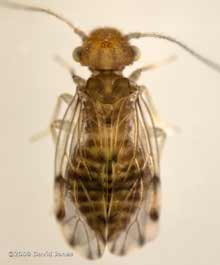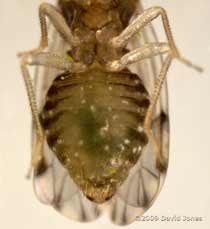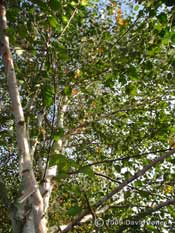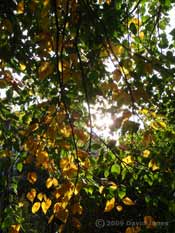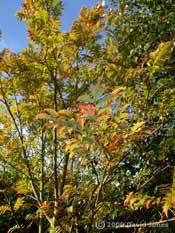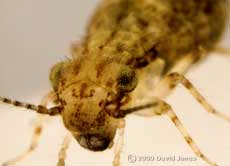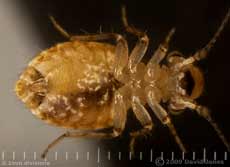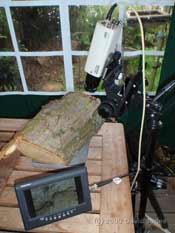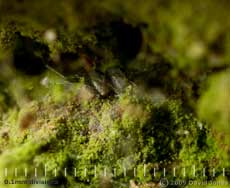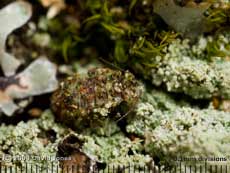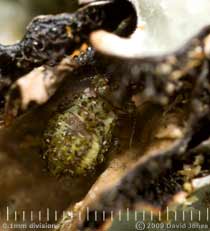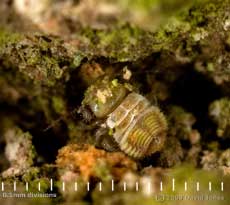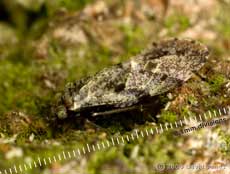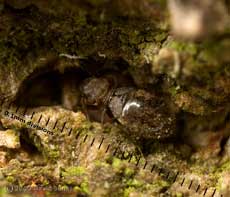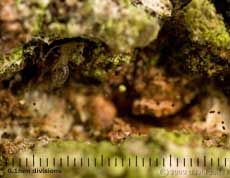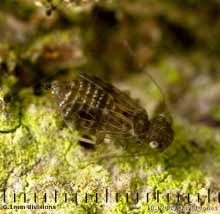Go to the last entry on this page .....Go to previous entry1 October - A bright, if hazy start to the new month. While my camera is still set up for extreme close-ups I thought I'd follow up on yesterday's barkfly pictures by recording another of the very small ones, collected from the same place as yesterday's example.
This one is somewhat lighter, and looks more like what I expect of Ectopsocus petersi, with narrower brown bands on the abdomen. Also, its wings extend beyond the tip of the abdomen. It measures about 1.5mm in length. Notice the group of three ocelli, or simple eyes, that form a small triangle in the middle of the head.
Once again, photographing the underside was problematic and for the moment I have just this picture(I may add other pictures later). The green colouring within the abdomen suggests that this barkfly has already eaten some algae this morning!
Something much larger escaped my camera lens in the early afternoon. I was just going out of the house to put some bits into our composter when the sound of a couple of noisy Rooks had me looking up, expecting to see them mobbing a Heron, something that we see from time to time. However, this time, instead of annoying a Heron they were pestering a Buzzard as it headed north, flying low and slow directly over us - If my big lens had been to hand I can safely say that the Buzzard would have filled the frame! While we see Buzzards high overhead, I've never seen one anything like this low here before. It was a real treat. A few minutes later my neighbour John saw it again, on its own, heading back to the south. For the rest of the day I'm using a cctv camera to monitor a Pseudopsocus rostocki (rare barkfly - see entry for 18 Sept)) which is tucked away under silk on one of the oak logs. I'm hoping that when it emerges I will get a chance to take more photographs of it feeding. Talking of cctv cameras, I have finally switched off the camera that was monitoring the bottom of the garden as I haven't seen any fox activity recorded over the last week or so. The camera will remain connected just in case it returns. This afternoon is pleasantly sunny. Mind you, while the temperature has almost made it to 21C in the shade on the veranda, at the bottom of the garden it is just 16C in the wood store. With painting now under way in our hallway, we need to keep doors open (thank goodness it's dry outside!) and it is actually warmer on the veranda than indoors by my computer.
4 October - After it was cloudy and quite windy yesterday, today was gloriously sunny, although I didn't get outside too much because work on the hall has now overrun its intended completion date (with a bit more painting to be done tomorrow), and the carpet fitters have been put off for a couple more days to let the paint harden and to give me chance to sort out a few last bits. With this distraction, I'm in danger of missing Autumn in the garden. Yesterday's winds shook leaves from both our and our neighbour's Birch trees.
Looking up into our Himalayan Birch, most of the foliage on the higher branches still has a bright green colour.
However, on some of the lower branches all the leaves have turned yellow. Rainfall during the month of September was some 40% lower than average, and I wonder if that is having an effect on the tree. Looking at the ground I see that as well as yellow leaves, quite a few green leaves have also fallen, and I find that when I tested some green leaves still on the tree, several of them came away easily. Also, I see very few leaves with the obvious patches of mildew that I usually expect to see in 'old' leaves.
I suppose that with the general lack of ladybirds in the garden this year it should be no surprise that I'm not finding any trace of Orange Ladybirds on the tree at the moment.
The Rowan's leaves are also turning, with touches of red all over the tree. It has been a bit disappointing this year. After its best show of flowers yet, no berries matured.
Returning to the barkfly theme, the day before yesterday I took a few more close-up pictures, this time of a Cerobasis questfalica, a species with only the smallest trace of forewings, and a characteristic 'anchor' mark on its head.
Again, as well as photographs from above I tried to record its ventral surface, especially the region at the rear of the abdomen to show the external genital structures. If you look at the large images, notice how the white marks seen on (or should that be in) the abdomen change over a two hour period.
My monitoring of the Pseudopsocus rostocki has come up with some interesting observations. After a few technical hiccups were solved I have been recording continuously since 8am yesterday. The picture shows the (temporary) setup on our veranda, with the camera linked to my time lapse recorder.
When the recording started at 8am the barkfly was just a couple of centimetres away from its silk shelter, and was feeding on algae. That session lasted some twenty minutes before it returned to the shelter down in a wide crack in the bark. Once there it stayed for the next four hours. Something that has puzzled me about P. rostocki has been the lack of faecal pellets in and around its shelter. With most of the barkflies I've seen here, the presence of these pellets has been a helpful indicator of their presence. Anyway, that mystery was solved when at 2.15pm the barkfly started moving about, climbed up out of its shelter and turned so that its rear end pointed away from it. A faecal sac was produced. When most of the pellet had emerged there was a pause for a moment or two, and then instead of simple dropping to the surface it was projected away from the abdomen at high speed, and out of the image frame, too fast for the video setup to record at 25 frames per second. That done, it headed back into the shelter and spent a few minutes grazing on the algae at the side of the crack. I can't help likening the process to a toy pop-gun, with the cork poised at the end of the barrel until you press the trigger! It was 6pm before it left again, projecting another pellet before going a couple of centimetres away to graze. Another pellet was projected while it ate. After that it returned to the shelter and stayed until 2.13am when it left just after another (unidentified) barkfly came close to the shelter. Rostocki wandered about, grazed just a bit and returned to the shelter where it remained active for about twenty minutes. At 7.37am it once again emerged, reversed away from the shelter and produced a pellet before starting to feed. This time the pellet seemed to get caught up on a silk thread. The barkfly was back under the silk by 8.25am, and stayed there all morning. It was 1.33pm before it emerged again to project another pellet at least four body lengths away. It retired into the shelter immediately but grazed on the algae in there for a minute or so before becoming still again. At around 4pm an E. petersi arrived in the area and started grazing. It may have disturbed rostocki which became active down in the crack. Ten minutes later it climbed out of the crack and started wandering in the area around the shelter much more than previously, but not grazing, and I didn't see any faecal pellets produced. When it returned under the silk at 4.26pm it did appear to graze then. From around 4.50pm an E. petersi appeared frequently in the small area covered by the camera. At 5.55pm rostocki decided to leave once more, and this time immediately headed away from the shelter and out of the camera's field of view. It has not returned all evening (it is 10.30pm as I write this). I have not attempted to find it tonight. In stead, I will be leaving the camera running all night in case it returns.
5 October - A dull, grey and wet start to the day as we get the first rain of the month. It looks as though I will need to take my magnifying lens to the log again this morning after P. rostocki didn't return to its shelter during the night. The recording showed just springtail and mite activity, and one visit to the image by what I think was an E. petersi. Well, a long search failed to locate the barkfly, but with lots of places to hide on the log I could easily have missed it - I won't be giving up on it this week.
In the meantime, a close inspection of the abandoned shelter provided another surprise. Unless I'm very much mistaken there are two eggs in there. Whether or not these were laid by rostocki I can't tell, but they are certainly the right shape and size for barkfly eggs. Their location makes it impossible to get any pictures from another direction.
While I couldn't find rostocki, and didn't see any any E. petersi, I did come across a single Peripsocus milleri adult and a couple of nymphs of (I think) Loensia variegata. These nymphs attach debris, including faecal pellets to themselves as camouflage.
While that first nymph wasn't feeding, the second example seemed to be nibbling at the underside of a foliose lichen.
6 October - Another grey and wet morning - and no decorator! His excellent work was finally completed yesterday. Now, I have just a few more things to do today before the carpet is laid tomorrow. A check of the overnight recording revealed no barkfly activity of any sort on the small area of log, approximately 23x47mm, covered by the camera. There were mites and the occasional springtail. Later today I may 'capture' a few of the mites to take a closer look.
7 October - The greyness continues after a very mild night with the temperature peaking at around 17C shortly before 1am. It dropped to 12C by 10am and was back up to15C at 1pm. Although it didn't rain during the first part of the morning, which was fortunate as the hall carpet was being installed (another job well done - it looks great!), it is raining steadily this afternoon. Yesterday my 'few more things' ended up taking all day and into the late evening, so there was no photography done. In fact, the evening almost came to a disastrous ending when I managed to tip half a cup of milk over the laptop. My immediate reaction was to flip the laptop over before mopping up and perhaps this saved it from damage. All seems to be well with it today, so I shall keep my fingers crossed..... One good thing about hunting barkflies on logs is that I can do it sitting down, and this morning I did exactly that. The P. rostocki continues to evade me since it disappeared two days ago, but other barkflies were more obliging this morning.
In the previous entry I included pictures of the camouflaged nymphs of Loensia variegata. This morning I found several more in the same area of a log, and this time I was able to take a photograph of a very early almost 'nude' nymph. Notice how even its eyes are covered with short hairs. I suspect that it is to these that the debris is attached.
On another part of the same log I also found this adult L. variegata.
On that log I also found what I belive is an adult Lepinotus patruelis, a species that I last came across in April last year, also on a log although I didn't record the tree type. Described as rare in the outdoors in Britain, it is a species that is naturalized in Britain and is common indoors, having been distributed by human activity. I've never found one indoors here!
Less than a centimetre from it, in the same crack on the oak bark I found this much smaller nymph under silk which was 'decorated' with faecal pellets. I wonder if this is the same species?
This individual has shorter (brachypterous) wings. It also has very prominent rings of white 'beads' in its abdominal segments. It is just about to expel a faecal sac, although I wasn't able to tell if this was just dropped or projected as was the case with the P. rostocki. In the absence of the latter, perhaps I shall set up the cctv camera to monitor this species.
Click on images to see larger version |
|
